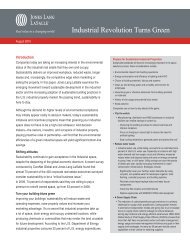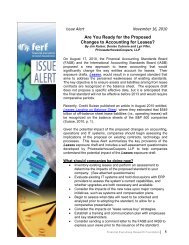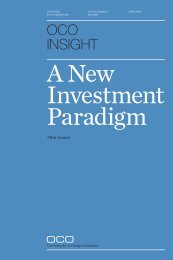PDF: 21st Annual Corporate Survey Complete Results - Area ...
PDF: 21st Annual Corporate Survey Complete Results - Area ...
PDF: 21st Annual Corporate Survey Complete Results - Area ...
You also want an ePaper? Increase the reach of your titles
YUMPU automatically turns print PDFs into web optimized ePapers that Google loves.
FIGURE 20<br />
move offshore. In fact, in November 2005, The Tax<br />
Foundation released a study showing that the United<br />
States had the highest overall corporate income tax rate<br />
(39.4 percent combined federal and sub-federal) of all<br />
countries in the Organization for Economic Cooperation<br />
and Development (OECD).<br />
This may explain why state and local incentives held<br />
its fourth-place ranking this year, receiving an 88.6 percent<br />
rating in importance from our survey respondents,<br />
actually up from 86 percent last year. And, tax exemptions<br />
jumped up two places in the rankings to sixth<br />
place this year, with an 86.7 percent rating, up from<br />
83.6 percent in 2005.<br />
Some 47 percent of the corporate survey respondents<br />
consider tax incentives the most important type<br />
of incentive when making a location decision; 29 percent<br />
of the respondents look for financial incentives like<br />
grants and loans; and about a quarter consider other<br />
incentives like free land, infrastructure support, and<br />
training as most important (Figure 26).<br />
In fifth place in the rankings is availability of telecommunications<br />
services, receiving an 88.3 percent rating.<br />
This factor was in 11th place last year but gained 8.5<br />
percentage points and six places in the rankings. However,<br />
availability of high-speed Internet access dropped<br />
from its fifth place position in 2005, with an 85.7 rating,<br />
to 10th place this year, with 82.1 percent of the survey<br />
respondents rating this factor as either “very important”<br />
or “important.” This year’s respondents seem to have<br />
rated Internet access as a sub-factor of telecommunica-<br />
2006<br />
2005<br />
2004<br />
Expect to expand existing facilities at present location within:<br />
0 20 40 60 80 100<br />
1 Year<br />
FIGURE 21<br />
22% 19% 8% 5% 46%<br />
22% 13% 13% 6% 45%<br />
25% 16% 14% 4%<br />
41%<br />
2 Years<br />
3 Years<br />
4 Years or more<br />
No plans<br />
Total number of new jobs to be created by company’s expansion(s):<br />
FIGURE 22<br />
2006<br />
2005<br />
2004<br />
Fewer than 20 — 37%<br />
20–49 — 31%<br />
50–99 — 11%<br />
100–499 — 17%<br />
500–999 — 2%<br />
1,000 or more — 2%<br />
Expect to relocate a domestic facility within:<br />
0 20 40 60 80 100<br />
1 Year<br />
FIGURE 23<br />
11% 11% 14% 4% 60%<br />
9% 7% 7% 4% 72%<br />
21% 12% 5% 3%<br />
59%<br />
2 Years<br />
3 Years<br />
4 Years or more<br />
Primary reason for planning a relocation:<br />
No plans<br />
Labor costs — 20%<br />
Labor availability —8%<br />
Operating/occupancy costs — 18%<br />
Proximity to suppliers/markets served — 28%<br />
Need for improved business climate — 8%<br />
Quality-of-life concerns — 5%<br />
Other — 13%







